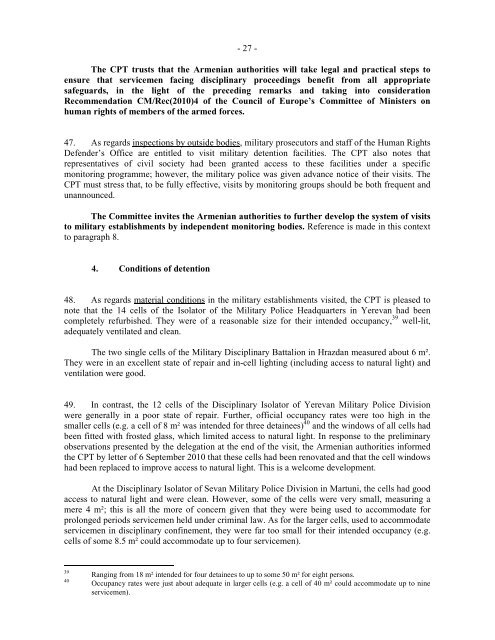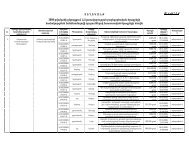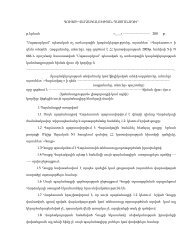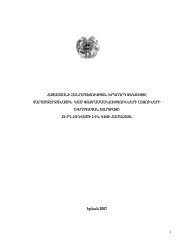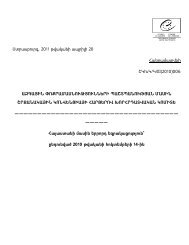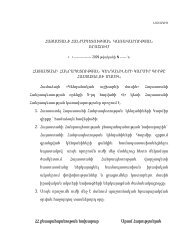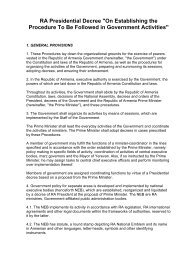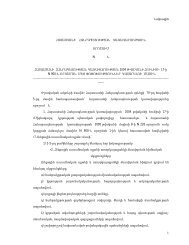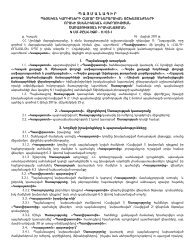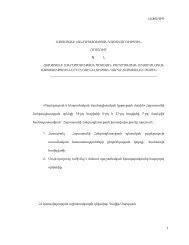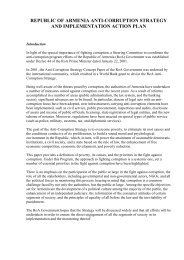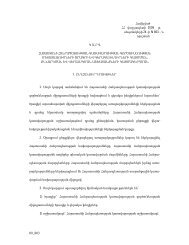CPT _2010_ 82 - EN - Report Armenia 2010 _2_ - The Government ...
CPT _2010_ 82 - EN - Report Armenia 2010 _2_ - The Government ...
CPT _2010_ 82 - EN - Report Armenia 2010 _2_ - The Government ...
You also want an ePaper? Increase the reach of your titles
YUMPU automatically turns print PDFs into web optimized ePapers that Google loves.
- 27 -<strong>The</strong> <strong>CPT</strong> trusts that the <strong>Armenia</strong>n authorities will take legal and practical steps toensure that servicemen facing disciplinary proceedings benefit from all appropriatesafeguards, in the light of the preceding remarks and taking into considerationRecommendation CM/Rec(<strong>2010</strong>)4 of the Council of Europe’s Committee of Ministers onhuman rights of members of the armed forces.47. As regards inspections by outside bodies, military prosecutors and staff of the Human RightsDefender’s Office are entitled to visit military detention facilities. <strong>The</strong> <strong>CPT</strong> also notes thatrepresentatives of civil society had been granted access to these facilities under a specificmonitoring programme; however, the military police was given advance notice of their visits. <strong>The</strong><strong>CPT</strong> must stress that, to be fully effective, visits by monitoring groups should be both frequent andunannounced.<strong>The</strong> Committee invites the <strong>Armenia</strong>n authorities to further develop the system of visitsto military establishments by independent monitoring bodies. Reference is made in this contextto paragraph 8.4. Conditions of detention48. As regards material conditions in the military establishments visited, the <strong>CPT</strong> is pleased tonote that the 14 cells of the Isolator of the Military Police Headquarters in Yerevan had beencompletely refurbished. <strong>The</strong>y were of a reasonable size for their intended occupancy, 39 well-lit,adequately ventilated and clean.<strong>The</strong> two single cells of the Military Disciplinary Battalion in Hrazdan measured about 6 m².<strong>The</strong>y were in an excellent state of repair and in-cell lighting (including access to natural light) andventilation were good.49. In contrast, the 12 cells of the Disciplinary Isolator of Yerevan Military Police Divisionwere generally in a poor state of repair. Further, official occupancy rates were too high in thesmaller cells (e.g. a cell of 8 m² was intended for three detainees) 40 and the windows of all cells hadbeen fitted with frosted glass, which limited access to natural light. In response to the preliminaryobservations presented by the delegation at the end of the visit, the <strong>Armenia</strong>n authorities informedthe <strong>CPT</strong> by letter of 6 September <strong>2010</strong> that these cells had been renovated and that the cell windowshad been replaced to improve access to natural light. This is a welcome development.At the Disciplinary Isolator of Sevan Military Police Division in Martuni, the cells had goodaccess to natural light and were clean. However, some of the cells were very small, measuring amere 4 m²; this is all the more of concern given that they were being used to accommodate forprolonged periods servicemen held under criminal law. As for the larger cells, used to accommodateservicemen in disciplinary confinement, they were far too small for their intended occupancy (e.g.cells of some 8.5 m² could accommodate up to four servicemen).3940Ranging from 18 m² intended for four detainees to up to some 50 m² for eight persons.Occupancy rates were just about adequate in larger cells (e.g. a cell of 40 m² could accommodate up to nineservicemen).


